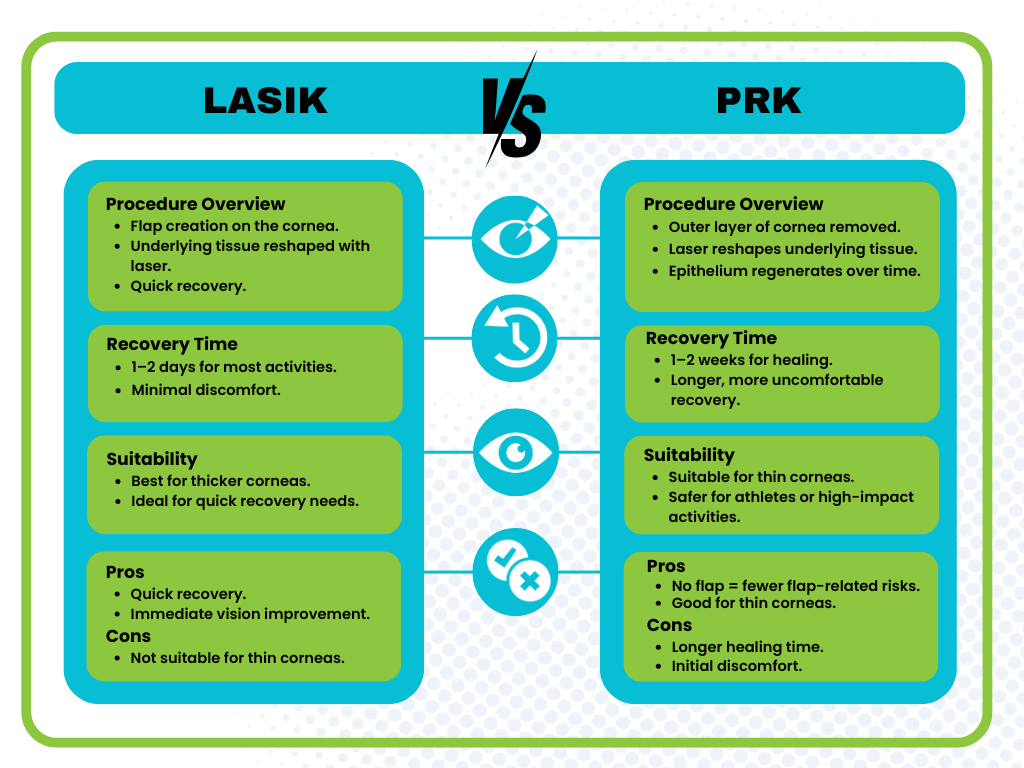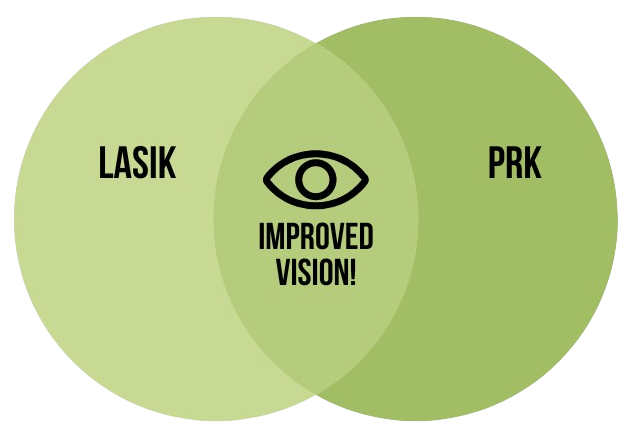The Difference Between PRK vs LASIK
LASIK is the most well-known laser vision correction procedure, but there are other types of laser eye surgery too. Photo Refractive Keratectomy (PRK) is another type of laser eye surgery procedure. For some people, eye structure can make PRK a more desired option, and may be your doctor’s recommendation if your corneas are too thin to perform LASIK. So, what’s the difference between LASIK vs PRK?
The end goal of any laser eye surgery is to promote better vision. PRK eye surgery was actually developed before LASIK, but both procedures are still in use today. Both PRK and LASIK are focused on reshaping the cornea, which affects how the eye focuses light. The aim of both procedures is to address vision problems like nearsightedness, farsightedness, and astigmatism by gently reshaping the cornea with a laser.
The PRK & LASIK Procedure
The big difference between LASIK vs PRK laser eye surgery is how the eye is prepared for surgery. With LASIK, the surgeon creates a hinged flap by making an incision in the cornea. This flap gives the surgeon access to the part of the cornea that needs to be reshaped. Once the procedure is finished, the surgeon will put the flap back in place.
With PRK, there is no flap. Instead, the thin, outermost layer of the cornea, called the epithelial layer, is removed to provide the necessary access to the part of the cornea that the doctor reshapes with the laser. This outer layer regenerates naturally during the healing process.
LASIK vs PRK: Key Differences
LASIK and PRK are two of the most popular vision correction procedures, each offering unique benefits. Understanding the differences can help you make an informed choice.
LASIK involves creating a thin, protective flap on the cornea, then reshaping the underlying tissue with a laser. This method provides quick visual recovery, usually within 1-2 days, and almost immediate improvement in vision. It’s ideal for those with thicker corneas and who want fast, effective results.
PRK, by contrast, does not involve creating a flap. Instead, the outer layer of the cornea is removed before the tissue is reshaped. While the recovery period is longer (1-2 weeks), PRK eliminates any flap-related complications, making it a safer choice for those with thinner corneas or individuals involved in high-impact sports or activities.
Both procedures effectively correct vision, but the choice depends on factors like corneal thickness, lifestyle, and recovery preferences. While LASIK offers faster visual recovery, PRK may be the safer option for certain patients. Consulting an eye care professional can help determine which procedure is best suited to your specific needs.

The PRK & LASIK Recovery
Healing occurs quickly after LASIK surgery, while PRK takes a little longer to heal. Patients often report more discomfort from having PRK than from having LASIK, but it is temporary, while your eye is healing. While the healing time is different between the two procedures, the expected results over time are the same.

PRK and LASIK are more alike than they are different, but the differences are important. If the incision required to create a LASIK flap isn’t right for your unique needs, PRK may provide another option for laser vision correction. As always, please remember that it is crucial to speak with your LASIK surgeon before making any decision on how to proceed with any laser vision correction procedure.
Schedule your free LASIK consultation today and determine if laser eye surgery is right for you. The LASIK Vision Institute has performed over 1.4 million procedures and offers convenient, nationwide locations!
Schedule A Free LASIK Consultation

Find a LASIK Surgery Location Near You
We’re located nationwide – it’s easy to find a LASIK Vision Center near you.
Categories:



